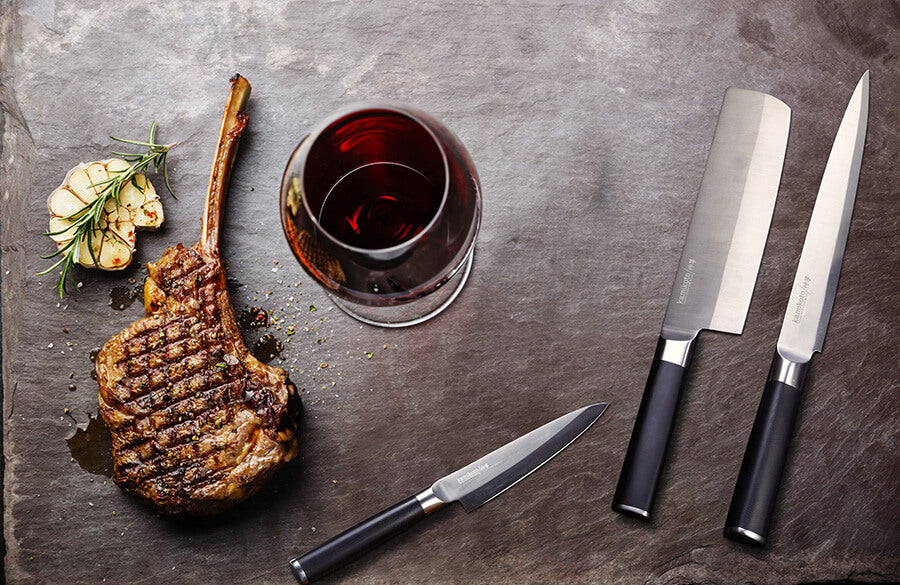
Wine holds great power as it can both complement and enhance the flavor of a beautiful meal, or quickly ruin it. Choosing the correct vintage according to cuisine is therefore extremely important to ensure the diner’s experience is pleasure-filled, rather than a culinary disaster.
Why Wine Pairings Aren't Just for Fine Food
Food and wine pairings have evolved immensely over the past few decades and no longer sit solely in the domain of haute cuisine. While it seems that for every rule, there is a naysayer that opposes it, there are a few general guidelines one can follow when attempting to match the best wine to a certain dish or cuisine.
-
Understand the elements: It is first important to understand the distinct elements inherent in both wine and food. Generally, all wines are made up of alcohol, fruit, sugar, acid and tannin. Food likewise contains acid and sugar but also salt, fat and further flavors. The best food and wine pairings take all these elements into account and ensure they balance one another out, rather than compete.
-
Create the right balance: match the wine’s intensity/strength and acidity level to the same components in the food. They should be comparable, however the wine can slightly dominate. For example, a Pinot Grigio is perfect for a fish dish as its lightness allows the fish flavor to sing through. Pairing the same dish with a heavy Merlot would overpower the delicate fish flavor. A Merlot is a much better accompaniment to a rich meat dish that can handle the robust flavor of such a wine.
- Consider the region: Often the area in which the wine is grown and produced will be the best indicator of its flavor profile. Taste testing works well to determine the individual flavors present in a wine but so does viewing the label notes.
Some general guidelines when pairing wine and food
- Heavy, strong flavored foods suit heavy wines (ie a casserole and a Cabernet Sauvignon)
- Light mild-flavored foods suit light wines (grilled fish and a Pinot Grigio)
- Salty, sour foods can make wine taste fruitier and less acidic
- Sweet and savory foods can make wine taste stronger or drier
- Steamed, sautéed, or poached foods work well with light wines
- Grilled, roasted or baked dishes with strong flavors lend themselves to medium to heavy wines
- Salty dishes are good with acidic wines
- High-tannin red wine suits high-fat food such as meat or cheese as it cuts the ‘dry-mouth’ feel
The Right Wine Pairings for Italian Food
Just like the French, Italians are well known for producing some of the world’s finest food and wine, focusing on regionality and seasonality. Therefore, when choosing the right wine for an Italian-inspired dish, look at the dishes roots. Try to pick a wine from the same region as it will have similar flavor profile as the dish.
Having said this, experimenting with wine from other regions can also produce some wonderful and surprising results.
Some Italian food and wine pairing suggestions:
For tomato-based red sauces (pasta, stew, pizza, risotto, red-meat based dishes):
RED WINES
- Italian Chianti
- Cabernet Sauvignon
- Merlot
- Pinot Noir
- Sangiovese
For cream or oil-based dishes (pasta, pizza, risotto, seafood dishes):
WHITE WINES
- Chardonnay
- Prosécco
- Pinot Grigio
- Riesling
- Sauvignon Blanc
The Right Wine Pairings for Greek Food
As Greek food often comprises multiple courses served family style, choosing an appropriate wine can be slightly tricky. However, focusing on the predominant part of the meal – say a whole spit-roasted lamb – is one way to make a good selection.
Some Greek food and wine pairing suggestions:
- Meze (ie dips and pita bread) – a light red like a Pinot Noir or Sangiovese
- Salads - Sangiovese
- Fish, seafood and poultry-based dishes - Pinot Noir, Chardonnay, Riesling, Rosé
- Lamb/beef - Syrah/Shiraz, Merlot, Cabernet Sauvignon
- Red-sauce based dishes - Cabernet Sauvignon or Merlot
The Right Wine Pairings for Mediterranean Food
Mediterranean cuisine varies widely with a strong focus on fresh fruits, vegetables, grains, cheese and yogurt, as well as white and red meats. In similar way to Greek food, it’s often served in multiple courses all at once so when picking the right wine, it is wise to consider this. Also keep in mind the rule of selecting a light wine for a light course, and a heavier one for a rich dish.
Some Mediterranean food and wine pairing suggestions:
- Salads – Moscato, Sangiovese, Riesling, Zinfandel
- Lamb/beef - Syrah/Shiraz, Merlot, Cabernet Sauvignon
- Fish, seafood and poultry-based dishes - Pinot Noir, Chardonnay, Riesling, Rosé
- Rice-based dishes - Rosé
The Right Wine Pairings for Indian Food
Indian cuisine centers on bold, big flavors which can clash with certain wines. Heat is another factor as well the plethora of condiments - such as chutneys - that are traditionally served alongside main dishes. As such, selecting the right wine is all about balance. Often opting for a simple wine flavor profile works well.
A general rule is to avoid highly tannic wines such as a Cabernet Sauvignon. It is better to choose one that is acidic with a fruity undertone and some sweetness. Sparkling wines are a good choice as is a Rosé. Many food experts recommend chilling the wine beforehand which can help to counteract the heat of curries or other spicy dishes.
Some Indian food and wine pairing suggestions:
- Rich red meat-based curries & highly spiced dishes – Syrah/Shiraz, Pinot Noir
- Light curries (ie Korma) – Rosé
- Cheese-based curries (paneer) – Riesling, Sauvignon Blanc
- Vegetarian – Chardonnay, Riesling
- Overall (most dishes) – Rosé, off-dry whites like Pinot Gris or fruity reds like Grenache
The Right Wine Pairings for Mexican Food
Mexican cuisine combines vibrant flavors with fresh herbs or sauces to either tame the heat, or fire it up further. One interesting way to choose a good wine for Mexican food is to consider the dominant flavor in the dish and then pick accordingly.
Some Mexican food and wine pairing suggestions:
- Salsa & chips: Sparkling wine
- Cheese-based: Sangiovese, Zinfandel
- Meat-based: Tempranillo
- Herb or citrus-based (cilantro, lime etc): Pinot Gris, Riesling
- Smoky flavor (ie chipotle): Malbec
The Right Wine Pairings for Spicy Food
While spicy food is mostly commonly associated with Indian cuisine, there are many others that enjoy serving up a liberal dose of heat. Thai, Chinese, Ethiopian, Malaysian and Jamaican are but a few. When picking a good wine to accompany spicy foods, it pays to keep in the mind the following:
- Go for lower alcohol, higher acidity content – they have a crisper finish & counteract heat (sparkling wine is a good option)
- Avoid high oak & tannin wines – spices can enhance these flavors, creating a bitter finish
- Opt for something slightly sweet – sugar can have a cooling effect
Some spicy food and wine pairing suggestions:
- Sparkling wine
- Rosé
- Sauvignon Blanc
- Riesling (especially good with yogurt-based curries or Thai stir fries redolent with herbs)
- Zinfandel
- Syrah (good with highly spiced meats)
The Right Wine Pairings for Mild Food
Not all cuisines rely on heat to create flavor. Subtlety also produces a memorable and tantalizing result. For dishes that have mild flavor profiles, it makes sense to choose wines that have the same. The whole point of a mild dish is to allow a delicate ingredient to shine and a heavy wine will overpower it, ruining the desired outcome.
A few mild food and wine pairing suggestions:
- Pinot Grigio, Chardonnay, Rosé, Sauvignon Blanc: suit light dishes like salads, raw dishes, shellfish/seafood, goat cheeses, lightly seared chicken
- Cabernet, Pinot Noir, Malbec: great match for steak, grilled or barbecued meats
- Sparkling wine: oysters, simple canapes
- Zinfandel: Pâté
While these food and wine pairing guidelines are by no means comprehensive, they are a starting point in working out some good matches. As in many things in life, the rules are made to be broken so experiment with different flavor profiles to discover what works best for you.
Furthermore, wine is the not the only good pairing for certain types of food, cocktails can also be an interesting choice. Whatever you choose, trial and error is the best way to learn, extend your culinary prowess and elevate your skills.


